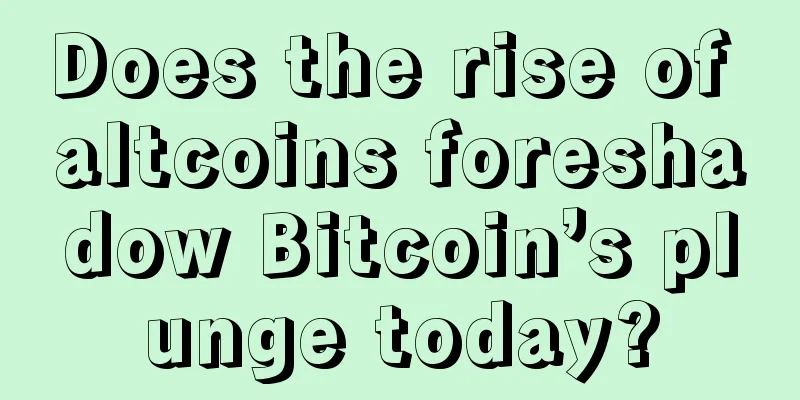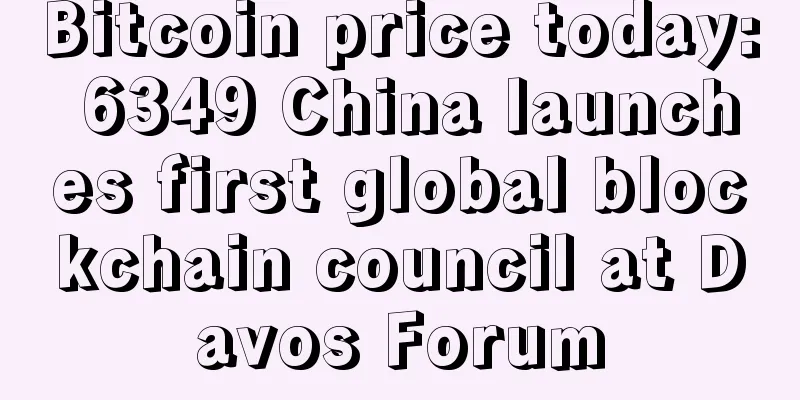Does the rise of altcoins foreshadow Bitcoin’s plunge today?

|
Today (November 26), Bitcoin suddenly plummeted, from a low of 18913 to 17125, a drop of thousands of dollars. Did the rise of altcoins in the recent rebound supported by Bitcoin foreshadow this information in advance? In this round of rebound mainly supported by Bitcoin, many other currencies are also rising at full speed. Does this mean that this positive trend will end early? Over the past few months, the crypto market has proven that Bitcoin, as the oldest cryptocurrency, is still the undisputed leader. It is the rally engine that drives everything, leaving other coins far behind. The word "crypto" has almost become synonymous with Bitcoin once again. But now, altcoins are fighting back. In the past seven days alone, almost all relatively popular coins have risen faster than Bitcoin. While Bitcoin has "only" risen by less than 15%, Ethereum (ETH), Litecoin (LTC), Polkadot (DOT), and Stellar (XLM) have risen by around 30%. In contrast, IOTA (IOTA) has risen by just under 40%, Cardano (ADA) has risen by nearly 50%, and Ripple (XRP) has even risen by an incredible 70%. Image source: coinmarketcap.com What is the reason? Why are these coins, and not others, soaring? Or is it just a way for capital to infiltrate the most diverse coins after acquiring Bitcoin, rather than randomly selecting old coins? Does the appeal of altcoins mean that the pressure of this rally has been reduced? Because now the fiat currency is no longer exchanged for Bitcoin, but for altcoins. Ethereum and other altcoins before ETH2 launch At least at the Ethereum level, one can argue that the rally is based on fundamental data. After all, the second-largest cryptocurrency is looking forward to the launch of the Beacon Chain in early December. At the same time, more than 300,000 ETH out of the necessary approximately 524,000 ETH has been staked, according to which not only the launch of ETH2 has become more likely, but also a certain portion of ETH can be taken out of circulation. 300,000 ETH is, after all, only 0.3% of all available ETH. (At the time of translation, ETH2.0 has completed the staking target) In the case of Cardano, you’ll find that progress has been slow (or too slow) in terms of blockchain decentralization, new partnerships with banks and other companies, and bringing “blockchain applications” to market. For example, for a supply chain that is not particularly novel after five years of blockchain discussion, it is still in demand. Is this combination enough to justify its price increase of nearly 50%? The project itself is not good, but at least the constant news shows that Cardano is very viable. And that may be enough to win in a speculative market that is slowly reaching FOMO. Ripple is in a very similar situation. Again, we don’t have any major positive news about Ripple, but there are still some drops that show that Ripple Labs is actively exploring. For example, the new wallet XUMM has entered the App Store, the hard fork of the XRP ledger has also introduced smart contracts, and the "Utility fork" will also distribute flare tokens to all Ripple holders. So even if there are no major breakthroughs, there are some progress. There is no data to show that Ripple will replace Swift anytime soon, nor is there any evidence that XRP is increasingly used for international transfers. However, the work that Ripple Labs is doing, and the loyalty of Ripple fans on social media, are enough to make this progress explode. Looking at IOTA, the situation is no different: the major breakthrough, namely shutting down the coordinator to achieve the decentralization of the Tangle, has not yet been achieved. But to this end, the IOTA Foundation has cooperated with the German University of Technology Aachen, the Fraunhofer Institute and some companies, opened up a data market, won the TM Forum award for digital transformation, and announced good progress in the second phase of Chrysalis, which is part of the future architecture of IOTA. Perhaps these small improvements are not in line with what the project hoped for three years ago, but they are still signs of vitality. If these simple and refined signs of life are enough to allow these coins to take off along the trajectory of Bitcoin, then what does this mean for those coins that have not yet found their way into the accelerated upward territory? BCH, BSV, DASH "don't even" reach 20% profitability, while the likes of MXR, FIL, NEM or ATOM have only 10% or less profitability, far lower than Bitcoin. Although there are disadvantages, they are "only minor" First, some of these coins are showing signs of weakness. For example, BCH got rid of ABC's tax. But for the market, this only means further instability, changes in developer leadership, and unpredictable roadmaps. Bitcoin Cash's adoption as a payment method is as faltering as ever, and even Roger Ver and his marketing machine Bitcoin.com seem to be slowly losing steam. Similarly with BSV: Craig Wright continued to disrupt, but after he was beaten black and blue in his attempt to prove himself as Satoshi through the legal system, he had to quit. At least he is taken less seriously than ever in public outside the BSV community. Even Calvin Ayre has gone quiet. BSV itself has basically stagnated; the healthy growth and enthusiasm that distinguished 2019 is gone. Even Dash coin doesn’t know what to report on anymore, and Dashnews.org magazine has nothing to write about. Dash will never see mass adoption, no matter how much people want to find out. Looking at Monero, although it has finally picked up a bit, it is still far from becoming an important means of payment in terms of transaction volume. At the same time, Monero has faced greater resistance than most other cryptocurrencies. For example, it was delisted by other platforms such as ShapeShift. This is likely to scare investors, so despite Monero's strong technical characteristics, it has not benefited from the current rebound. In addition, there are many other coins worth mentioning. For example, Stellar (XLM) is spreading rapidly in Germany; Polkadot (DOT), the developers of Parity promise to create interoperability between blockchains through Polkadot; Chainlink (LINK), whose oracle is increasingly needed by DeFi. Of course, there are many others, but this is not what we are going to discuss. What does the rise in altcoins mean for current price action? We are not oracles, after all, so we can only speculate here and, in the spirit of good dialectics, present the strongest arguments for the contradictory alternatives so that the reader bears the responsibility of choosing for himself. On the one hand, the infiltration of funds into altcoins could be a completely normal market mechanism for the crypto market. Investors can enter the market with Bitcoin, just like holding Dax to enter the stock market, and then start diversifying their investments. One needs time to understand Bitcoin, but it takes more time to get familiar with altcoins so that at least an investment decision that is not completely coincidental can be made. From this perspective, the rise of altcoins will be a good sign of stability. The crypto market will also operate as usual. In fact, the rise of altcoins now may mean that the beginning of the rebound is right. On the other hand, this is also part of the market's usual mechanism, and altcoins usually take off when the rally is over. If there is nothing more to be gained on Bitcoin, then greedy and not necessarily smart investors will try to take advantage of altcoins. Especially Ripple, which has quadrupled in value even after the Bitcoin bubble burst. From this perspective, we can see the rise of altcoins as a signal that the market rally is over. On December 18, 2017, Bitcoin reached its all-time high of nearly $20,000. Excluding Bitcoin, the market capitalization of all coins peaked about three weeks later, on January 7, 2018. The choice of altcoins shows the absolute desperation of capital. The rise of Ethereum is probably understandable in the context of Defi and ETH2. And it is also conceivable without the massive expansion of Bitcoin. Ripple (XRP), as a cryptocurrency, has not made any major moves this year; at least not in the past month, but has witnessed a 70% increase in its price. Similarly, Cardano and IOTA are likely to be disappointing after careful analysis, even if the cooperation and research announcements of these two blockchains are wonderful, they are still far behind their goals and promises this week, which lays the foundation for violent price fluctuations. But this is all part of the mechanics of cryptocurrency, where the fundamental data of various coins is far less important than the overall dynamics of capital flows, which inevitably flow from Bitcoin to altcoins and then slowly back to Bitcoin. |
Recommend
Ethereum vulnerability discovered, DAO put to the test
Rage Review : The DAO project raised $160 million...
Cryptocurrency prices continue to fall, Bitcoin miners' income has dropped by more than half from its peak
On-chain data shows that Bitcoin miners’ revenue ...
Is a woman with a wide nose good looking? What's her temper like?
Women with wide noses have very gentle looks. Eve...
Beijing Securities Regulatory Bureau: No promotion of virtual currency projects or platforms
Original title: Further precautions against risks...
What is the fate of people with moles at the corners of their eyes? They are slow-tempered and difficult to be appreciated by their superiors.
How to interpret moles around eyes? As we all kno...
These types of people are best at doing business
These types of people are best at doing business ...
Solutions to public chain management vulnerabilities
Rage Comment : I believe this is the first time t...
Bitcoin whales snap up $4.3 billion in BTC during price drop
Bitcoin whales haven’t accumulated so much Bitcoi...
Eight facial features of women who can give birth to a son
Eight facial features of women who can give birth...
What does black eye socket mean?
Dark eye sockets will make you look very listless...
The main analysis of the characteristics of the four white eyes and their fate. Do people with four white eyes have good personalities?
People with four white eyes have a strong desire ...
What does physiognomy say about moles on the facial features?
my country's traditional physiognomy includes...
Cryptocurrency trading platform LZF opens trading services to 49 states in the United States
Laissez Faire (LZF), a digital currency trading p...
The facial features of a girl who is rich and powerful, such a girl is best to marry
When a person is born, his family will wish him a...
How to tell if double love lines are good or not in palmistry
Is it good to see double love lines in palmistry?...









